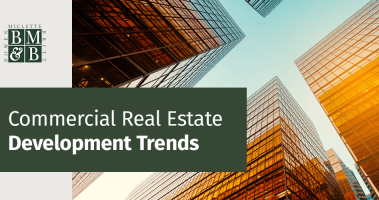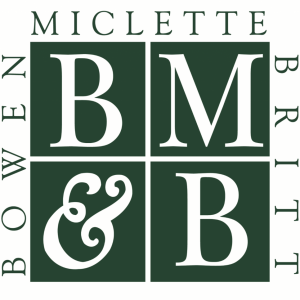
Business owners across the construction, real estate, energy, marine, transportation, and other industries should understand commercial property development trends to anticipate the future of commercial real estate. Risks such as liability verdicts, environmental exposures, and rising workers’ compensation costs have made it essential to work with a team of experts in the real estate sector.
The State of Commercial Real Estate
Following record levels of investment and funding in the commercial real estate sector, emerging trends in real estate indicate that commercial real estate is beginning to slow down. Interest rates are on the rise and growth is slowing, which has led to new uncertainty and challenges in the commercial real estate market. Investors are now redefining success and adapting their strategies. While there are some concerns about the macroeconomic climate and inflation, unemployment rates remain close to pre-COVID-19 pandemic levels and labor markets remain strong.
Investors are drawn to apartment complexes and multi-family housing due to the housing supply shortage and rising rents. Sales have also been high for retail, industrial and office spaces.
Commercial Property Insurance Trends
The market for commercial property insurance has hardened recently, and rates have been consistently increasing for years. Some insured entities may encounter coverage restrictions and above-average rate increases, especially those at risk of catastrophic perils such as wildfires and hurricanes. Policyholders located in areas prone to natural disasters or those conducting high-risk operations will likely continue to be vulnerable to coverage limitations, ongoing rate increases, and other trends impacting the sector.
1. Supply Chain Issues Affect Commercial Real Estate Insurance Costs
Supply chain issues, such as metal and lumber, have led to several material shortages. These issues have affected the costs of property construction and valuation. As a result of these shortages, many building materials have fluctuated in price. Though lumber has fallen from its steep cost, the costs for materials such as tubing and copper piping have dramatically increased. These higher costs can challenge insurers to estimate future costs for pricing and underwriting purposes.
In today’s insurance market, valuation is vital for businesses to ensure sufficient protection. Preventing coinsurance penalties starts with accurate insurance-to-value (ITV) calculations. Inaccurate ITV calculations happen for different reasons and are all too common for the industry with about 75% of all commercial properties are undervalued, leading them to become underinsured.
2. The Casualty Market Rises at a Slower Rate
Auto and general liability rates continue to rise but at a slower pace. Casualty buyers may pay more for lead umbrella layers. However, overall excess liability spending could be lower than in previous quarters. This decline is due to greater competition in the market. Most companies can anticipate a drop in their costs for workers’ compensation coverage, which continues to be profitable.
3. Natural Disasters Increase Commercial Property Insurance Rates
As natural disasters grow in severity and frequency, they continue to pose concerns for the commercial property insurance sector. Between January and September 2021, 20 weather-related disasters occurred in the United States that caused losses in excess of $1 billion. The average number of these weather-related disasters was just seven between 1980 and 2020. Catastrophic events can cause severe property damage that costs both insurers and insureds. These costs may increase in the wake of above-average wildfire, tornado, and hurricane seasons, along with worsening floods and hailstorms.
If a major storm strikes a densely populated region, hundreds or thousands of homes may require repairs or even replacement. With costs of materials already high due to supply chain issues, damage from storms can push the costs for materials, labor, and insurance even higher for commercial properties. For example, Hurricane Ian increased property insurance rates by about 5.3% in the commercial market and 4.6% for personal lines during the third quarter of 2022, even for property insurance buyers who don’t own properties in Florida. Reinsurance capacity is predicted to be restricted, which will affect rates for property insurance buyers.
4. Inflation Issues Impact Business Building Insurance Coverage
Significantly high inflation levels have impacted various sectors and industries, including commercial building insurance coverage. Inflation issues have led to increases in property construction costs. Ongoing labor shortages in the construction industry have also compounded concerns and resulted in higher labor costs and more project delays. Policyholders may experience greater claims severity as a result, along with underinsurance problems if losses lead to the need to replace business personal property or rebuild structures at higher costs.
Insurers’ loss reserves intended to cover future claims may also be affected by inflation. If the rate of inflation is greater than the rate for the reserves, insurers may be required to use reserves more quickly than expected. Long-tail insurance lines such as general liability could be impacted, as well, since losses for these coverages may be paid out over a lengthy period. Inflation problems are expected to continue, which could keep property losses and claims costs high.
Commercial Property Insurance in Houston
Commercial property costs in Texas are affected by insurance costs. Commercial property insurance covers the costs of repairing or replacing a building and business property after it sustains damage in a covered event, such as a fire or storm. This type of insurance may also cover some of the lost income if a business is not able to operate as normal.
Commercial Property Coverages
Coverage options that commercial property owners may require include:
- Crime coverage: Crime coverage can protect a business from different types of crime, such as cybercrime, employee theft, forgery, alteration, robbery, and burglary. Coverage can also protect money and securities against on-site or off-site losses.
- Flood insurance: Few commercial property policies cover flood damage. To protect a commercial property from flooding, a policyholder may need to purchase a separate flood policy. There is a 30-day waiting period following the purchase of a flood insurance policy before coverage is in effect.
- Valuable papers coverage: This insurance offers limited coverage for a company’s valuable papers and business records.
- Inland marine coverage: Inland marine coverage can protect commercial property and goods transported on land, such as computers, valuable papers, fine art, and contractor equipment.
- Extra expense coverage: This type of coverage covers the additional costs of restoring a business to normal after it sustains damage.
- Ordinance or law coverage: This coverage applies to extra repair costs or construction costs to ensure a commercial property meets current building codes.
- Hail and windstorm coverage: Businesses located on the Texas coast or on Galveston Bay may want to invest in wind and hail coverage. Coastal businesses can purchase wind and hail coverage from the Texas Windstorm Insurance Association (TWIA). Depending on the commercial property’s location, policyholders may need to purchase flood insurance before obtaining this coverage.
- Boiler and machinery coverage: This type of coverage insures machinery such as boilers, compressors, steam cookers, air conditioning units, and electric water heaters.
- Business interruption coverage: This coverage pays for lost income if a business is unable to operate normally due to damage or destruction.
- Newly constructed or acquired buildings coverage: This type of coverage insures a new building added to the policy.
Environmental Liability Coverage
Actual Cash Value vs. Replacement Cost Coverage
Commercial property policies offer actual cash value coverage, replacement cost coverage, or a combination:
- Actual cash value: This coverage pays for the replacement of commercial property minus depreciation. Policyholders who choose actual cash value coverage alone may not have enough coverage to fully rebuild their businesses.
- Replacement cost: This coverage pays for replacing or repairing commercial property at current costs within the limits of insurance, meaning the policy will replace or rebuild the property with like-kind & quality materials. This applies even if the costs are more than what the policyholder originally paid for the property. For full protection, a policyholder should purchase replacement cost coverage.
Levels of Commercial Property Insurance
There are a few levels of commercial property insurance, each of which protects against different damages or losses:
- Special form policy: This type of policy offers the most coverage, applying to damage from various causes of loss except for those specifically excluded from the policy. These policies may exclude damages from water, floods, vermin, insects, nuclear disasters, earth movement, and wear.
- Broad form policy: This type of policy usually offers the same coverage as a basic form policy, along with damages from falling objects, structural collapses, leaking appliances, and the weight of snow, sleet, and ice.
- Basic form policy: This type of policy offers the least coverage. It may cover damage caused by fire, smoke, hail, windstorms, lightning, vandalism, explosions, vehicle collisions, volcanoes, sinkholes, and riots.
While commercial all-risk property insurance has been affected by commercial property insurance trends, policyholders in Texas may want to invest in the proper coverage.
The Importance of Proper Commercial Property Valuation
The primary focus of property underwriters continues to be submitting accurate replacement cost valuations. The costs of rebuilding a structure with new, quality, and like-kind materials are on the rise.
What Is Property Valuation?
Property valuation is the process of assessing the property’s value based on a variety of factors, such as its condition, floor plan, location, lot size, and amenities. The value of a commercial property will also be influenced by supply and demand in that specific region. A professional surveyor carries out the property valuation, taking photographs and notes before sending a valuation report. A valuation report can be used to price a property before it is put on the market.
Property Valuation Decreases Risks
Valuation should be conducted on commercial properties to lower risks on all sides. If the insurer has incorrect information for pricing decisions, this can hinder profitability and make it difficult to offer the right level of protection. An improper valuation can lead to a coverage gap and unexpected expenses in the event of a claim, so it is essential to ensure property valuations are accurate.
Commercial Real Estate Market Outlook
The commercial real estate market continues to face the impact of lockdowns, travel restrictions, and the great resignation — an influx of employees voluntarily resigning from their jobs. The market is showing signs of stabilization, but there are a few factors that could impact the market.
Trends in the Commercial Real Estate Market
The following are some of the current trends in the commercial real estate market:
- Inflation: Inflation directly impacts the real estate market in several ways, including ownership-related costs such as debt, construction, vacancy, rent, and operating expenses. With a high cost of goods, investors may want to identify strategies to mitigate the risk of increasing costs.
- Recession fears: Real estate professionals and economists are in debate about whether we are headed for a recession. A recession may directly impact the commercial real estate market, leading to vacancies, unemployment, reduced buyer pools, and weakened property values. The economy can greatly influence the commercial real estate market, and its performance could give investors a glimpse of the market’s future.
- Increases in interest rates: Interest rates have been increasing sharply. As concerns around recession and inflation mount, the debt market has shifted considerably, resulting in higher interest rates. To combat inflation, the Federal Reserve has raised the federal funds rate several times. Commercial property owners should monitor interest rates as they continue to rise and lenders tighten loan parameters, which could significantly affect commercial property values.
Houston Real Estate Market Update
In Houston, office space inventory has increased and occupancy gains have increased. In the Greater Houston area, the industrial real estate market has also expanded. A disparity between slower product deliveries and higher demand has led to a low rate of industrial space vacancy. With higher demand than supply and higher-cost facilities, rental prices are rising and expected to continue climbing.
Other Texas cities are among the top real estate markets in the nation. The Dallas and Fort Worth markets are large, diverse, and affordable, resulting in economies that draw in various businesses. Austin has experienced both population and job growth, contributing to strong appeal for real estate investors.
Contact Us to Learn More About Commercial Real Estate Insurance
At Bowen, Miclette & Britt Insurance Agency, LLC, we focus on developing comprehensive insurance programs to mitigate risks and risk management costs. Facing higher lead umbrella pricing and larger verdicts? Consider commercial umbrella insurance to extend liability limits over general liability, auto, and employers’ liability.
As an insurance broker, BMB represents consumers who are searching for insurance coverage. For more than 40 years, our role has been similar to consultants. We do not sell insurance directly as insurance companies do. Instead, we may find a policy for clients through one of these companies. We focus on various financial solutions, such as risk management, employee benefits, and estate planning. Commercial coverages offered range from crime insurance to builders risk insurance, commercial property insurance, and others. Improve valuations, resilience, and safety by engaging loss control services for property risk assessments, site audits, and business continuity planning.
We are licensed in all 50 states and have ranked among Business Insurance’s Top 100 Brokers and Top 35 Privately Owned Brokerages. We are more than insurance—we’re assurance. Contact us for answers to common commercial property insurance coverage questions.


